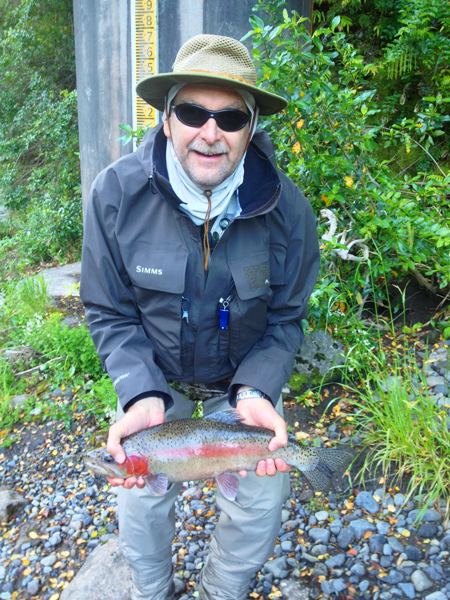 '
'Information Page.
Tongariro trout.
For those readers of the blog who are keen on fly fishing my pal Alan has been doing some trout fishing in New Zealand. He sent me the following report of a week spent by him and his son Hamish on the famous Tongariro River. Now from what I gather the rainbow trout in the River are approaching their spawning season but they look as though they are in mint condition (it shows that 'close seasons' are largely tosh, as does the 12 month still water open season in England). Anyway, it's obviously fantastic sport and as always Alan's writing brings it to life so here goes -
Hi Mike,
Trust this note finds you and Lilian in the best of everything and unaffected by the storms lashing the UK coast. Seems like you have been out and about prior to the storm, the 8 lb. bass and large pike both top captures.
As you know Hamish and I have been down to Turangi to fish the mighty Tongariro river over the past week and the fishing ranged from tepid to excellent. We travelled down on Sunday 1st December on a postcard perfect day. Blue skies, few clouds, plenty of sun washed down with a gusty breeze from the SW and a pleasant temperature of 23 degrees C. Perfect fishing conditions.
When we arrived at the Tongariro River Motel the owner, Ross Baker, gave us a thorough briefing as to where the fish were holding and being caught. Ross has an encyclopaedic knowledge of the river and its comings and goings. He recommended the upper river near the Poutu intake and to specifically target the run where the white water rafts are launched from as he’d seen a pod of fish there yesterday. Brilliant!
Hamish was eager to get cracking so after a quick brew and a healthy wedge of birthday cake, slathered in ground almond icing, we tackled up and set forth. The Poutu intake is around 20 minutes’ drive south from Turangi. It is essentially a dam that represents the upper fishing limit on the Tongariro and the spillway pool is always crammed with trout in early December. We arrived at the car park near the dam at 3.15 pm and were greeted by bus loads of school boys who were just leaving after a day rich with aquatic activity. There was only one fisherman wetting a line and he was anchored in the spillway “honey hole”.
Within seconds Hamish was out of the car, tackled up and champing at the bit to get into it. Opting to stay well away from the fisherman initially, we headed for the raft launching pool that Ross had recommended. Everything he’d said was correct and there were at least a dozen trout holding in the fast flowing, thigh deep riffle. Hamish had tied on an size #14 Ostrich-herl nymph dropper attached to the bend of a tungsten-bead hares-ear bomb, which was perfect for the riffle. I told him to “fill his boots!” and within seconds he was up to his calves casting upstream of the pod. The first three casts were short but the fourth was perfect. The indicator tapped a tattoo as the nymphs bounced on the rocky bottom en route downstream. I saw a trout move towards the fly and the indicator stopped. “Strike!” I yelled but he was already onto it as the rod tip slashed upwards. The rod immediately assumed a healthy bend. He was in. It was a solid fish of around 2 ½ lb. which charged around the pool for about 5 minutes before he brought it into the shallows for netting. Great start. Was he pleased? You bet he was!
The reason for the fish activity was obvious. There was a huge amount of fly life in the margins and over most of the river. The raft pool pod had dispersed during the battle so we opted to head upstream to the “honey hole” (spillway pool) as the other angler had just left. We careful made our way up to the tail of the run out and discovered it was alive with a veritable phalanx of trout. They were stacked like sardines across an area the size of three double beds. There even was an occasional trout rising. I was drooling like Pavlov’s dog after his master had rattled the dinner bell.
I opted for a tungsten-bead-head bronze-wire epoxy bomb and glass-bead pheasant tail. Third cast and the fly line stopped mid-drift. I struck and was rewarded with the sight of a decent trout heading upstream at full throttle. The water was gin clear and every spot and sinuous movement was clearly visible. Unfortunately the fish was foul hooked as it shed the hook after the initial surge and when I retrieved the fly there was a scale neatly pinned on the hook. Within six casts I had hooked another. This fish was the mirror image of Hamish’s (2 ½ lb.) and I was able to fight and land it quickly below the main fish congregation. It got harder from here-on-in. Twenty casts later I snared a fingerling on the dropper. At this point I replaced the fly, as the glass bead had disappeared, with an Aoteapsyche colonica nymph (black bead, grey body).
The fly change was a revelation and within two casts I was hooked up again. This fish shot skyward like a Polaris missile from a nuclear submarine. You’d think the water was electrified as it immediately shot out of the water upon touchdown. Three more jumps, each higher than the last and a final twisting piked somersault which tore the hook free. "Oh bother!" I exclaimed to no one in particular. Groundhog day three casts later when another aerial acrobat repeated the display and spat the hook back at me with a contemptuous sneer. Five fish on and only two (including the fingerling) landed. Ugly viewing.
Nothing much happened after that so we decided to head back to the motel and fish the raft run as we went. The wind was now gusting upstream and this made it very difficult for Hamish to cast. He gave up in disgust after a few minutes, closely following a thwack on the back of the head with a bomb travelling at warp speed. He exited the water seething and seeing stars. Not one to miss an opportunity I started to systematically work the run up targeting the dark smudges which regularly swayed across the bottom. Nothing happened until I told Hamish this was my last cast. It arched up the run nicely and the flies dropped perfectly into the current seam. I mended and watched the fly line travelling downstream towards me. It paused for a second, I struck and everything came up solid. This fish jumped twice to show its proportions, and eye its tormentor, then turned tail downstream quickly. I was just able to stop it exiting the pool by applying heavy side. Grimaces all round. The jack did not want to move and buried itself amongst the rocks in the riffle tail. This signalled the start of 15 minutes of hard work. Trying to move a stubborn fish in a heavy current when it is only attached to you by a #16 nymph is difficult. I’d make a few metres and the fish would shake its head and take them back, often with interest. My arm was starting to feel the strain as the current was putting a prodigious curve in the fly line and 9’6” rod. Eventually I was able to draw it into the shallows where Hamish managed to get a successful net shot. As the fish was lifted from the water the fly slid out, bent at 45o and exhausted. The fish was only 4 lb. but it was solid across the shoulders and deep in the front third.
What a session. Seven fish hooked and only four landed in less than 2 hours.
2 December
The next morning dawned fine and sunny. Another beautiful day in paradise. After a leisurely breakfast we tackled up and strolled to the nearby river to fish the Major Jones pool for a couple of hours. Initially we targeted the riffle between the Major Jones and Island pools. To cut a long story short, I hooked two fish in the session on the dropper nymph and dropped them both after a short tussle. They were taking the fly below me in fast water and it was difficult to get a solid hook set with the small partridge and orange flymph.
There were lots of fish visible but they were very scary especially, as Hamish discovered, when they were presented with an white indicator. In hindsight, I believe we would have done better if we had increased the bomb weight as it was not bouncing the bottom enough. My fishing partner was not keen to do this though, as he still had a throbbing lump on the back of his head from the previous day. I also saw another two fish take my fly without being able to set hook. All in all, a frustrating session.
Later in the day we returned to the Poutu intake. Unfortunately two local fisherman were positioned in the honey hole and they went out of their way to make it impossible to fish alongside them. They waded in chest deep and when they hooked up they waded out through the tail of the run scattering any trout that were silly enough to get in their way. It was efficient but ugly stuff and they landed five fish in the half-an-hour that we watched. Eventually we returned to the raft pool. I changed back to 0.90 gram hare's ear bomb and green-bead-head chenille-flash nymph. Within three casts I’d hooked and lost two fish, both thrashing on the surface below me. The expert commentator opined that I should let them run but that was not an option as if they exited the riffle then it would mean crossing the river to land them. We only stayed around an hour at the Poutu before heading home for dinner.
In summary a disappointing couple of sessions. Four fish hooked - all lost. As I noted to Hamish when he was giving me lip, it is better to have hooked and lost than never to have hooked at all.
3 December
Tuesday dawned fine and sunny. A ditto day in paradise with an intermittent light zephyr nudging 5 knots gently caressing the water. Once again we dawdled down to the river after breakfast to fish the Major Jones between 8.15 and 10.15 a.m. I initially used bead-head bronze-wire epoxy bomb in the shallow riffle water and paired it with green-wire nymph initially. No touches. I then targeted the dark smudges holding in the shallow upper part of the riffle, increasing the bomb weight to 0.9 gram with a gold bead head hare's ear. I tried droppers of Partridge and orange, Snipe and purple (variant) and a single egg fly. No visible movement from the fish which carefully swayed out of the way as the nymphs passed through their midst.
After lunch we headed again to the upper reaches. Parking the car at the Blue pool we walked a couple of kilometres up to the Fence pool and then re-traced our steps trying hard to spot fish holding in the shallows. Hamish fished while I guided. Eventually we got back to the run near the car (wouldn’t you know it) and finally spotted a couple of fish holding in the Blue pool. Hamish decided to fish for the trout from the side rather than below with a bomb and hare's ear nymph dropper which, as it turned out, was an excellent idea as one fish moved to intercept the nymph on its fifth drift. The indicator dipped, Hamish struck and all hell broke loose. The fish tore around the tail of the pool for five minutes and went aerial a couple of times before we managed to net it.
Conditions were perfect to fish the evening rise in our favourite pool, the “Duck pond”. Fish were rising, albeit infrequently, when we arrived at 7.30 pm. I tied on a #16 March Brown female and cast over the most persistent offender. The fly drifted down the run drag free until it was intercepted by a neb and a swirl. I paid my compliments to the Queen and set the hook. Fish on. The trout tore around the run for a couple of minutes jumping once but was no match for the power of a 9’6” Hardy Angel Smuggler. 3lb. of silver rainbow jack. Short and stout. Twenty minutes later, after changing flies to a #16 March Brown male, I was able to repeat the exercise on a fish of almost identical dimensions. Sight fishing to rising fish with a dry fly. Fly fishing heaven!
By now it was dark and fish were beginning to rise steadily, the surface of the “Duck pond” awash with dimples and noisy splashes. Just as things were hotting up I touched a willow behind me on the back cast and ended up with a massive tangle as the trace formed an intricate macramé with the furled leader. I set to work trying to undo the mess when Hamish yelled out “I’m in!”. I stopped untangling and went to help out, placing my rod out of harm’s way. Hamish was desperate not to lose the trout and played it very carefully. It took to the air once but mainly stayed sub-surface and powered off strongly every time it was drawn into the shallows. Eventually we landed and released it. Believe it or not, I’d only just got back to my rod and tangle when he hooked up again…and again…and again. Four fish in succession. 35 minutes flew by in a blur; Hamish almost constantly hooked up and me standing in the margins acting as ghillie. He landed three of the fish and lost the fourth, all on March Brown variants. They were quality trout each around 3 lb. in weight and the one he lost went ballistic aerially before breaking off. This, fortunately, gave me time to untangle my leader while he tied on another fly in the gloom.
Re-entering the fray, I immediately missed two fish on the strike and ended up re-tangling the trace on the second as the fly caught on a frayed braid connector and spun into furled leader again. Time to pack up and head home as it was after 10.30 pm. What a night!
4 December
Overnight it started to rain and by the morning the river volume had increased from 23 to 27 cumecs and was carrying a tinge of colour. It was still eminently fishable though. I braved the rain to fish from 8.30 - 9.30 am in riffle below Major Jones. I used an epoxy bronze-bead-head bomb and ostrich-herl nymphs (bead and bead less), targeting visible fish. Couple of potential takes but nothing stuck. Increased bead head weight to 0.9 grams without any noticeable impact. I was struggling to read this section of river since it has changed subtly following the big flood in September. The current is now faster and the run marginally deeper which means heavier bombs and longer traces are necessary to get the fly down.
It rained steadily all day. To avoid cabin fever we had a short afternoon session in medium - heavy rain. We fished the riffle between Admirals and Kamahi which was quickly turning into more of a rapid than a riffle. By now the river up to 32 cumecs and was holding more colour. I used epoxy bronze-bead-head bomb and Greenwell’s nymph initially. Swapped the Greenwell’s for a San Juan worm to fish margins. No touches. Fished for around 1 - 1.5 hours.
5 December
It continued to rain steadily overnight and by the morning the water level was nudging 36 cumecs (50% more flow than on Tuesday). There was a slight tinge of colour but the river was fishable. We fished Hydro pool in the steady rain for 30 minutes at 2.30 pm. I used a high density sinking line which was a mistake as the Hydro pool is now very shallow in top third and I kept on hanging up on bottom after short drift. Lost two flies in four casts. I put on booby to try and keep fly out of rocks which was futile. Hamish used a nymph combo consisting of Hare's ear and bug eye Glo bug but was also finding the going difficult. The cricket called so we aborted and headed off the drown our sorrows in front of the TV.
The rain ceased briefly around dinner time so we opted to fished from 8.00-9.30 pm in "Duck Pond", even though the river was still rising. There was a heavy mist over the river (inversion layer?) which made fishing seem ethereal. Not a lot of activity. Both of us had one eye on a stick that we’d placed in the margins to gauge the river level though so we probably spent more time staring at that than the run. No touches or rises to flies. Interestingly the river rose to 39 cumecs while we were out and peaked at 46 cumecs (twice the flow versus Tuesday) early in the morning.
6 December
It was a cloudy overcast start to our last day in paradise. However the day steadily improved with sunny patches by lunchtime. We opted to try somewhere new and fished from 10.00 - 12.00 pm around the Braids area. The local council has cut down a lot of trees to try and keep the river flowing in a set channel and left a lot of stumps in the river so it is a visually unattractive place to fish. We saw plenty of fish around the "Old Plank" pool but they intent on spawning. We tried numerous bomb / nymph combinations (including single egg Glo bug) during the session but these did not elicit any interest form anything piscatorial. In river snags and willow trees did however rise readily to our flies.
By dinner time the sun was out, the river had dropped bach to 32 cumecs and the evening was very pleasant. Time for one last hoorah fishing the evening rise in the “Duck Pond”. The fish were also enjoying the weather improvement rising freely. Again I nailed a brace early in the twilight. Casting to rising trout with a #16 Hofland’s Fancy, dead drift, classic rise and strike after making the appropriate salutation to the Queen. Solid 3 – 3 ½ lb. fish in excellent condition which gave a great account of themselves. I nailed a third about twenty minutes later just as it started to get dark. Hamish was still to get off the mark and was feeling the pressure.
As the night darkened however Hamish came into his own hooking three fish, landing 1. One of the fish he lost was an absolute stonker. It resisted the rod for about 10 minutes and continued holding in station about 30 metres out from the bank shaking its head like a heavy metal fan at an AC/DC concert. Eventually it shook out the fly much to Hamish’s disgust.
Meanwhile I managed to spot a fish rising against the far bank in the gloom. I covered it with a long cast, saw the swirl and came up solid on a jumper. This hen took to the air and jumped at least five times during the fight. It sped around the pool for a solid 15 minutes before finally giving up. It was a 4lb. fresh run bar of silver. The perfect way to end the trip. Overall we hooked 4 fresh run fish on dry flies! This is apparently not supposed to happen and conventional wisdom is that fish running up to spawn do not feed. Yeah right!
Over the week we hooked 25 fish and landed 15. My personal tally was 9 from 17. Not my best work! Great fun. Best time of the year to fish the river. The evening rises are world class.
Tight lines and best wishes,
Alan Bulmer
It all sounds like fantastic fun and I have to say that although I’m no great fly caster I think I’d enjoy it. The scenery itself would be worth a visit. I have to say that after all the talk of #16 Hare's ear nymphs and other fanciful creations I would be longing for my old Rapala but I know it's not allowed. I replied as follows -
Hi Alan,
Excellent trip! Clearly the trout take a fair range of flies. Hamish seems to have got the hang of it now and is competing with 'the master'. Tell him that I'm an expert at whacking myself in the back of the head.
I guess that the heavy bead-heads that you use would be good for grayling in my rivers. I must give the Czech nymphing another go some time. Just too many things to try I'm afraid.
I've had a couple of river sessions recently. I tried a little fat plug with a violent action. No sign of chub, perch or pike but I had a small 'out of season' trout and a few other trouty follows. One was a decent fish which chased the lure into a foot of water making a huge bow wave. It had been resting in the shallow tail of a huge pool and looked like a rainbow (pink) but was probably a small salmon (a rarity in that river).
I also went with Nigel. He float fished maggots for the grayling but only caught a small trout (too sunny he said?). I tried my big Slandra for pike but couldn't buy a bite so I put on the little plug I mentioned and, first cast, had a salmon of about four pounds (again out of season). So after releasing it I packed in.
Thanks for the pictures and the report.
All the best,
Mike.
If you have any comments or questions about fish, methods, tactics or 'what have you.'get in touch with me by sending an E-MAIL to - docladle@hotmail.com
Nice fish.
 '
'Flies.
 '
'Hamish.
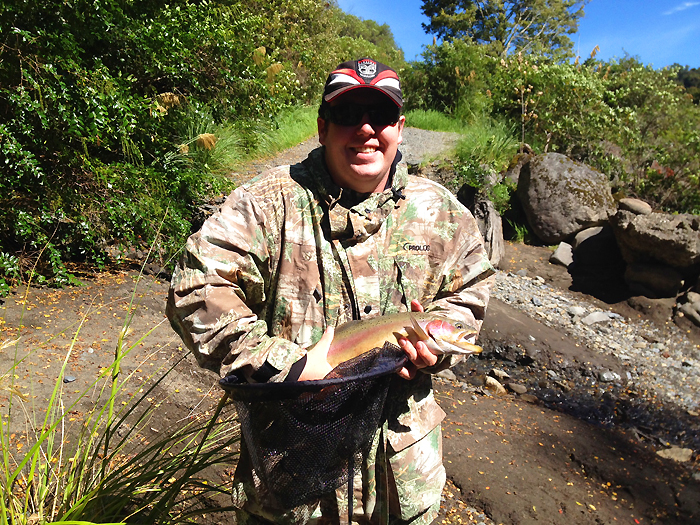 '
'-- and again.
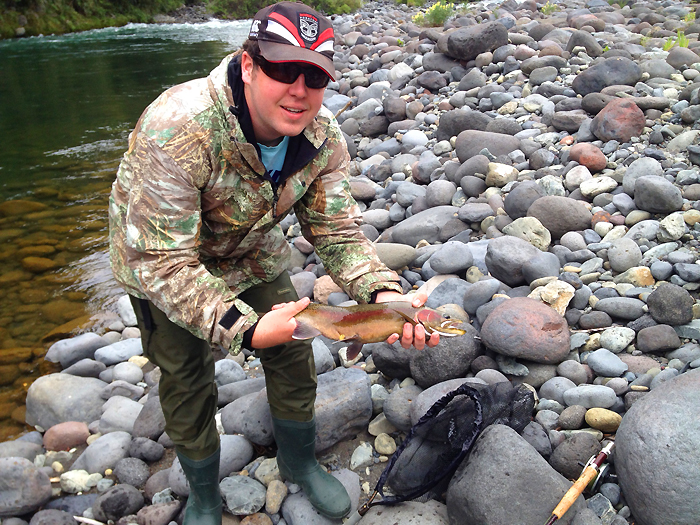 '
'-- and another.
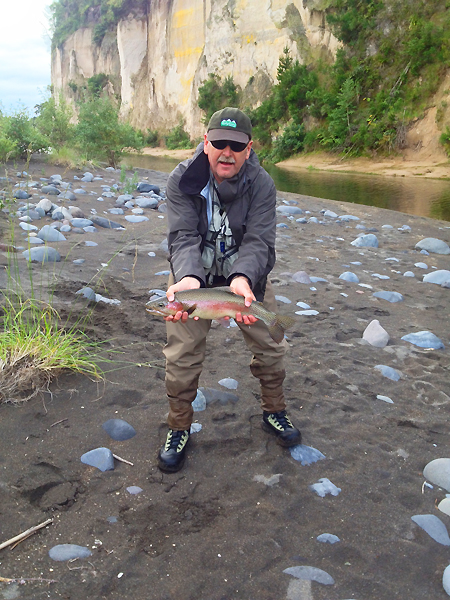 '
'Last day.
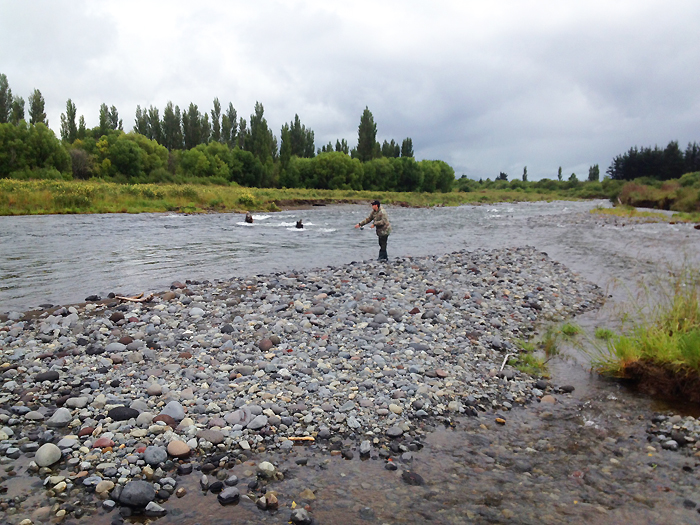 '
'Aetopsyche.
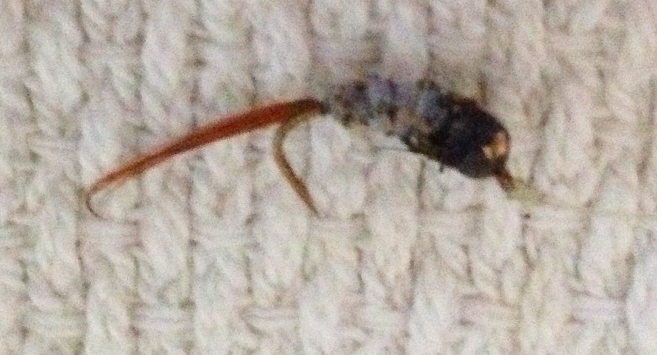 '
'